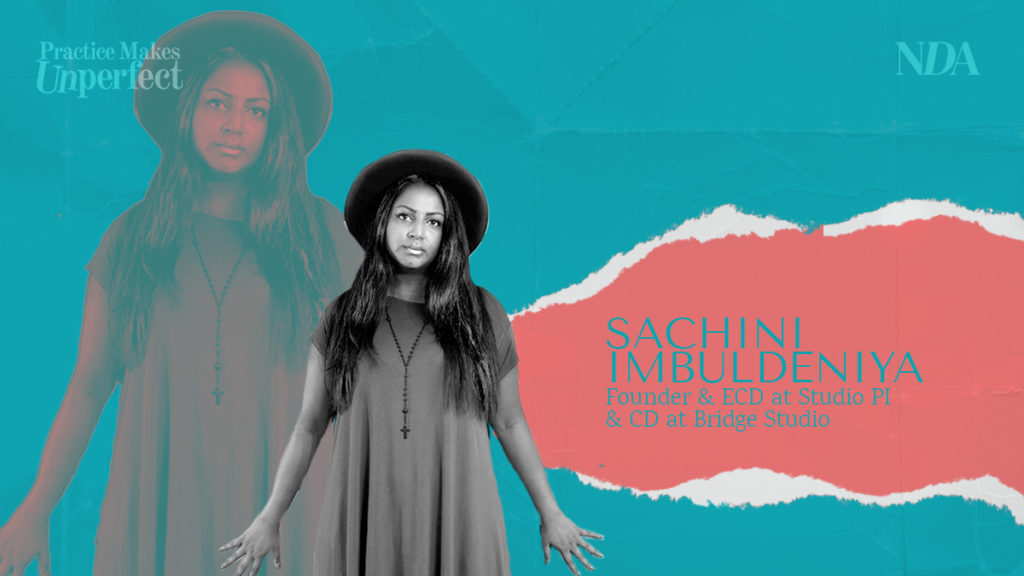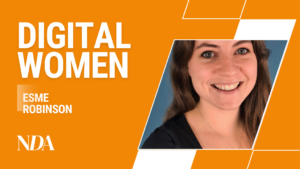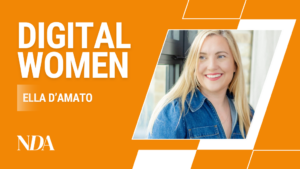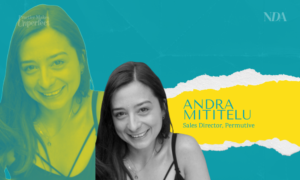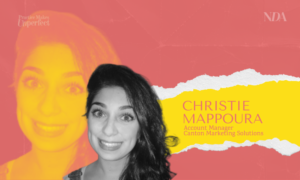These articles have been written by the latest cohort of the Practice Makes UnPerfect programme – a course that helps women find and finesse their public voices.
By Sachini Imbuldeniya, Founder & Executive Creative Director at Studio PI and Creative Director at Bridge Studio
We can all agree, I hope, that diversity is important. You probably say as much on your social feeds and when talking to your HR team and to recruiters.
But you may not have thought about why it matters, beyond the rather abstract notion of ‘fairness’.
Without creative diversity, we run the risk of stifling our industry and perpetuating the same tired old creative ideas made in the same old ways. It’s about fairness, yes. But it’s also about making our work – and our whole industry – better.
But we’re not there yet. The UK Government All-Party Parliamentary Group for Creative Diversity found four categories of people that are significantly underrepresented in our industry: women, people of colour, people living with disabilities, and people from working class backgrounds.
You could say I have a vested interest in supporting people that fit into these categories: I belong to all four. I know what I’m talking about too: I’ve spent nearly two decades working in a media world where mine was the rare brown face in a sea of white, where my ideas have been ignored or belittled, where I’ve had to work twice as hard to achieve half as much.
So, it matters to me. A lot. I founded Studio PI in October 2020 to try and tackle that disparity. It’s a photography and illustration agency that only represents exceptional individuals that fall into at least one of those underrepresented groups.
It’s been an eye-opener.
Most people I speak to about Studio PI – the ‘gatekeepers’ of commissioning artwork for clients and for editorial publications – are lovely, and supportive. They applaud the work I am doing. They share my horror at the fate of George Floyd, at the widening gender pay gap, at the ongoing culture war waged between women and trans people. They too want to Do Something about it.
But then, somehow, nothing happens.
Sure, they post a black square on Instagram, and sign the petition, and stick up the BLM sign next to their NHS rainbow in their living room windows.
But that’s not Doing Something about it.
And then it turns from ‘We Must Do Something’ into ‘Something Should Be Done.’
And always, always, I hear the same responses. The same weak, duff arguments made about why, when Something Should Be Done, what that person means is ‘by someone else.’
What they mean is: ‘I’m not the problem’. And as if by magic that means that if they’re not the problem – they’re not one of the awful racist people – then they don’t need to be part of the solution. They can carry on as they are.
But they can’t.
Desmond Tutu (may he rest in peace) said: “If you are neutral in situations of injustice, you have chosen the side of the oppressor.”
These people don’t see themselves as part of the same ugly mob that declare ‘Britain First’ or despise women in the workplace. They would be horrified, in fact, if you ever suggested to them that they are. But, by doing nothing, that’s where they are.
So, they get defensive. They hide behind excuses. Certain phrases people use to defend why, when Something Must Be Done, they haven’t quite gotten around to doing anything about it themselves.
To save time I repeat them here, with my typical responses for each. If you commission artists as part of your job and you recognise any of these phrases, then it is worth thinking about the difference between being an ally and a bystander.
Because to paraphrase Desmond Tutu: if you’re not helping us, you’re hurting us.
Things people say to defend their lack of support for diversity:
“I’m not racist.”
Let’s start with the big one, shall we? We work in an industry that’s quite lefty, quite ‘right-on’ and progressive, and most of the picture editors, art directors, art buyers and producers I know are demonstrably not racist – many are our champions and are very aware of diversity issues.
But it’s often very much a ‘front-of-camera’ diversity. They point to the great black footballers and models and celebrities they’ve worked with, but rarely to the black photographers, hair and make-up artists, stylists or crew. It’s as if diversity only exists if it’s visible; if it’s in front of the lens and not behind it.
Identifying racism is difficult. It doesn’t always turn up in bovver boots with a skinhead and swastika. I ask commissioners to look not at their collection of images they’ve published, but also at the people that did the work. How many black photographers have you used in the last month? The last year? Ever?
Black and Ethnic minorities make up 32% of the London population but only 11% of the creative industry. Let’s take that lower bar: are eleven percent of your photographs taken by black and minority ethnic artists?
And, if they’re not, can you see how that might look a bit racist?
“I went with this [white] artist because they’re more talented/better suited/more experienced.”
This is harder to tackle, because ultimately art is subjective. But it’s still inherently, systematically unfair.
An example:
When we put together the roster for Studio PI, we curated a longlist of 60 amazing artists and ran a ‘blind’ judging panel – removing all names and bios – so they would be judged solely on the quality of their work. 50 judges from the industry – all senior commissioners – rated a particular artist higher than all the rest. This artist has a back catalogue with some of the best brands in the industry in their book. So why, then, are they passed over for someone more ‘suitable’?
They have the talent – the industry said so. They have the experience – their portfolio says so. So, what holds them back?
Perhaps it’s the issue of ‘black exceptionalism’. Throughout history ethnic minorities have had to prove themselves extraordinary just to be considered ‘good enough’. An obvious example of this: Donald Trump was considered equally qualified for the US presidency as Barack Obama.
It’s unfair to hold a black or ethnic minority – or a woman, or a disabled person – to a higher standard than anyone else. It’s like asking black sprinters to start from ten metres back, and with no running shoes.
One time, my art director asked around the office for the nicest hands to use in a photoshoot. A quick straw poll later and it was deemed my hands were the nicest (weird, I know, but I do happen to have nice hands). He said: “they are really nice, but they’re brown… Oh, I know, we can use them and then photoshop them white.”
In other words, my hands were nice despite being brown, rather than their brownness being a feature. This is the exceptionalism that says that your ethnicity is a barrier you must overcome to be considered ‘good enough’.
The rapper Dave puts it best in his song ‘Black’:
“It’s workin’ twice as hard as the people you know you’re better than
‘Cause you need to do double what they do so you can level them”
If you are commissioning artists, all we ask is that you level them.
“Why don’t we put one in the mix”
I get this a lot: commissioners will present three options to the client. And if one of those artists is diverse, then that’s the diversity and inclusion box ticked, right? It’s not their fault if the client selects one of the other artists: the opportunity for diversity was there.
Sounds fair. So, let’s talk about American Football instead.
In 2003, the NFL introduced the Rooney Rule, which dictates that all teams must include a black or ethnic minority candidate in interviews for any senior coaching or operations vacancy. It came from a study showing that black head coaches, despite winning a higher percentage of games, were less likely to be hired and more likely to be fired than their white counterparts. (There’s that black exceptionalism again.)
At the time, there were only three black head coaches in the NFL. Fast forward twenty years, and the Rooney Rule has been so successful that there’s now… only one black head coach.
Box-ticking exercises do not work.
If you’re not pushing for real, impactful change in our industry, then you’re doing more harm than good.
“Why are we still talking about this/The D&I debate is over-done/*eye-roll emoji*”
There was a collective sigh of relief heard across the industry when Edward Enninful became editor of Vogue. You could hear the same sound when Barack Obama became president, and when Mahershala Ali and Viola Davis both won Oscars in 2017 after two years of #OscarsSoWhite trending on Twitter.
It’s the sound people make when they know Something Must Be Done, and then they’ve seen Something Being Done About It. It has a nice narrative finality to it, like a storybook ending. We needed more diversity, look, and here it is. The end.
So, to keep ‘banging on’ about it is considered bad form.
But I have to. Because one or two exceptions to the norm is not enough. We’re looking for fairness, and one or two black editors in a market of more than a hundred fashion magazines is not fair representation.
So, we keep going. And that really annoys people who wanted a pleasing end to the story.
And I totally get it. I bore myself sometimes when I bang the drum for diversity and inclusion. People roll their eyes at me. There’s an unspoken question too about why it matters so much to me when I have clearly ‘made it’ in my career.
Look. I know I am not exceptional. But I am still the exception – and for as long as that is true, we have more work to do. And it is exhausting. It’s like pushing a rock up a hill, every day. But it does matter. And there’s a really simple solution.
The easiest way to get me – and people like me – to shut up about it is to help me do something about it.
“I don’t see colour”
Apart from the obvious joke – if you can’t see colour then you probably shouldn’t be working in a visual industry – I hear this a lot, and from well-meaning friends as much as from clients and commissioners. ‘I don’t see colour; I just see people.’
And it baffles me.
My heritage is Sri Lankan, and I’m proud of that. It tells me a lot about who I am, it informs the way I live my life, it helps me to understand my family better and roots me in a culture that I love as much as the British culture I have grown up and work in. I want you to see that in me; and suggesting that you don’t – that we’re somehow all the same, really – doesn’t sound like progress to me.
But the worst part is what’s implied. By suggesting that it’s a compliment to not see my colour, you’re implying that my colour is a bad thing. It sounds an awful lot like ‘don’t worry, I don’t see all that problematic colour on you.’
John Barnes has spoken about this. He explains that even white people he likes have shown their innate racial bias. He says: “They’ve said ‘I don’t see you as black’ or ‘I see you as normal’ as if that is a compliment. They can’t say: ‘I see you as a black person’ because in their minds, subconsciously, that equates to them seeing me as inferior. Why can’t they see me as black and normal?”
The point is: people of colour are not getting a fair shake in our industry. In order to help them, you need to be able to see them.
And when you do see them, you need to give them a fair chance to prove their value.
Until that happens, I’m going to keep lending my voice to the push for a more diverse industry. Honestly, I’m as sick of it as you are.
But the unfairness and inequality of this industry – an industry I love – sickens me more.



